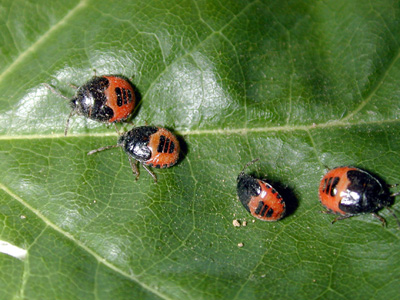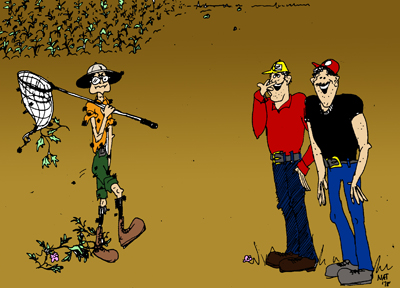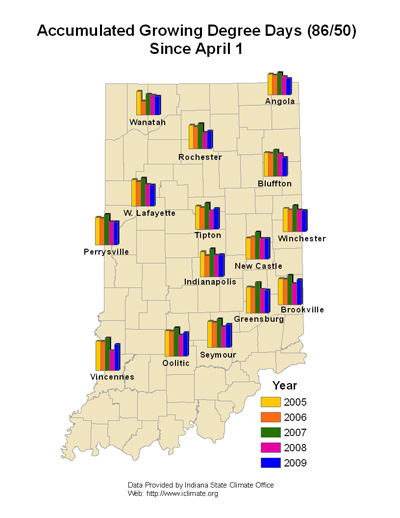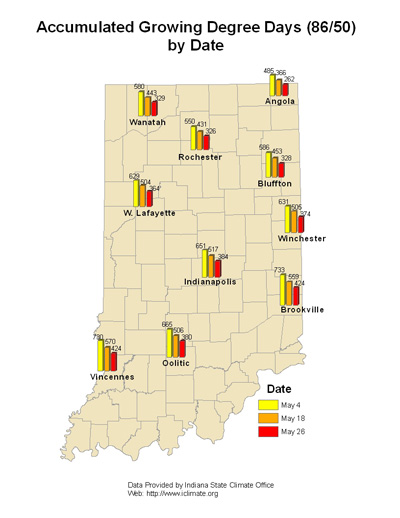Pest & Crop Newsletter, Entomology Extension, Purdue University
- Stink Bug Damage in Corn
- Japanese Beetles Emerging
- Lots of Little Black and Red Bugs in Soybeans
- Black Light Trap Catch Report
Stink Bug Damage in Corn - (Christian Krupke, John Obermeyer, and Larry Bledsoe)
- Stink bugs are seldom seen, but damage can be dramatic when bugs are present.
- Late planting into wet soils where seed furrow doesn’t close favors stink bug problems.
- Rescue treatments must be used before damage appears.
Reports from groups at this week’s Diagnostic Training Center indicate that stink bugs were busy this spring feeding on seedling corn. Perhaps now that fields are greening up, these occasionally-damaged early-whorl plants are being found. The situation that seems to favor the development of stink bug problems the most is one where corn is no-tilled following small grains (used as a winter cover crop) or planted into very weedy fields (an alternate host for stink bugs). When the cover crop or weeds are killed by herbicides, the stink bugs shift their feeding to the emerging corn.
Degrees of stink bug damage, from tillering to leaf tearing
Stink bugs feed on corn by inserting their straw-like beak into the stalk while injecting an enzyme, which helps digest plant tissue. They prefer to feed in the area of the growing point. When seed slots are not properly closed during planting, stink bugs may feed on this vital tissue. It is important to remember that spiking corn plants are most vulnerable to attack and damage. By the time feeding symptoms appear, the damage has been done and the stink bugs are likely gone. Symptoms vary, ranging from linear holes with a yellowish edge in the leaves, twisted or deformed stalks, plant suckering, and occasionally plant death. The damage can often be confused with many other causes, e.g., herbicide injury, rotary hoe, billbugs, etc.
Transverse holes on leaf with yellow "halo"
Sampling for stink bugs early in the season (at corn emergence) is difficult and time-consuming. High-risk fields with prior history of stink bug damage and/or where stink bugs are noted during corn emergence, especially if seed-slots are not properly closed, may require a rescue treatment of a foliar insecticide. In most cases, however, the best treatment is prevention: avoiding planting into wet soils if at all possible.
![]()
Japanese Beetles Emerging - (John Obermeyer, Christian Krupke, and Larry Bledsoe)
- Grub feeding is mostly over, now it’s the beetle’s turn.
- Watch for activity on soybean, and later on corn silks.
Yesterday at the Diagnostic Training Center, we dug up one Japanese beetle grub and pupa, and back on campus one beetle was observed. The good news is that the grub stage of this species has, or soon will, stop feeding. The bad news of course is that the voracious beetle is beginning to emerge.
This year’s adults are the result of eggs that were laid by female beetles last summer. After these eggs hatched in mid to late summer, the grubs immediately began to feed on roots and decaying organic matter in the soil. They continued feeding until cold temperatures prompted them to move deeper in the soil profile to overwinter. Early this spring, the surviving grubs returned to near the soil surface to feed. Spring root-feeding by the grubs can result in serious damage to early-planted crops, especially corn. Though expected because of the cool, wet conditions this spring, we have heard of very few grub problems this year, which underscores the unpredictability of this insect.
Adult Japanese beetle on soybean leaf
Japanese beetles will feed on more than 350 different species of plants, but are especially fond of roses, grapes, smartweed, soybeans, corn silks, flowers of all kinds, and overripe fruit. Beetle damage to cultivated crops is often minimal and defoliation (leaf removal) on soybean usually looks much worse than it is. The beetles often congregate in several areas of a soybean field - often field borders - feeding on and mating in the upper canopy. The beetles’ iridescent, metallic color and their proximity to the field edge catches the attention of those doing “windshield” field inspections. Closer inspections will often reveal that weeds such as smartweed have made fields even more attractive to the beetles. Look for more on this pest in future issues of Pest&Crop.
![]()
Lots of Little Black and Red Bugs in Soybean - (Christian Krupke and John Obermeyer)
- Burrower bugs are often seen in masses.
- They are displaced, once their host, likely henbit, is destroyed by tillage/herbicides.
- They are NOT a threat to our crops.
Shaun Casteel, Purdue’s new soybean agronomist, was in southern Indiana and observed numerous black bugs crawling on soybean plants. He had heard of one producer spraying for them. Others have seen masses of little reddish bugs crawling all over the ground. These insects are burrower bugs, and are closely related to stink bugs.
Adult borrower bug on soybean (Photo credit: Shaun Casteel)
Burrower bugs are 1/8 to 1/4 inch long insects with sucking mouthparts. The adults are black with a thin gray line around the edge of the body. The smaller nymphs, or immatures, are red and black. Both stages can be seen crawling over and under the soil and surface residue or accumulating in cracks in the soil surface. Burrower bugs can be abundant in and around no-till soybean and cornfields, as well as gardens and lawns. The species uses its sucking mouthparts to feed on sap from the roots of a wide variety of plants and developing seeds of henbit (think of the purple fields early this spring). There is no indication that burrowing bugs cause any injury to crops but densities of these bright insects have raised the concern of pest managers and homeowners.
Borrower bug nymphs (Photo credit: Kevin Black)
There is no known treatment threshold for burrower bugs. Considering their host is absent once herbicides/tillage have destroyed the weeds, they will likely “taste” the crop and move on. Under conditions of drought, their numbers might be a concern, but there is no evidence that is a problem thus far this season. Just an interesting observation for y’all!
![]()
Click here to view the Black Light Trap Catch Report
It May Pay to Recheck Fields for Weeds – (Tom Jordan, Bill Johnson, Glenn Nice, and Tom Bauman)
This year did not get off to a good start in Indiana. Rains delayed planting and some fields, especially soybean fields, were sprayed with a burndown herbicide treatment shortly before planting. Likewise, there were several days of cooler than normal weather for corn growth. In years where wet and cool conditions prevail, there are usually more hard to control weeds like smartweed present, and sometimes an early post application will not totally control such species, leaving them to regrow. Herbicides will not always work as well since translocation of the herbicides through the plants is not as great under these conditions and less than ideal control can be obtained. It may pay to scout fields to see if the herbicide programs have done the job on weeds that they are expected to do, and if not, then a second application should be planned on a timely basic to control these weed. Older weeds that regrow due to lack of control are much harder to control than younger weeds that emerge after the application is made. In addition to some of the hard to control weeds not being adequately controlled; cool wet conditions also can cause herbicides to injure emerging crop plants more than they would under warmer growing conditions. Usually this is temporary crop damage that will grow out of the injury in a short period of time.
Soybeans are growing slowly, even those planted early. Many fields show a good burndown, but new weeds are emerging. Weather conditions are forecasted to warm-up into the 90’s in the next few days and these weeds will grow rapidly. Be prepared to make early post treatments on these weeds before they get too tall and harden off. With the growing conditions the way they have been this year, the weeds may likely grow faster than the soybean crop. Contact herbicides should be used with care, as should any adjuvant or other spray additive that may cause excessive crop burn.
Consult Table 6 of the weed guide for corn <http://www.btny.purdue.edu/
Pubs/WS/WS-16/CornRainFast.pdf> and Table 17 <http://www.btny.purdue.edu/
Pubs/WS/WS-16/SoybeanRainFast.pdf> for soybean to obtain more information on rainfast intervals, maximum growth stage, and spray additives for postemergence herbicides.
Bug Scout
Looks like Bug Scout found the bur patch!
Dealing With DON in Wheat – (Kiersten Wise and Charles Woloshuk)
Wheat harvest is underway in southern Indiana and with high levels of Fusarium head blight (scab) in many fields this year, it is no surprise that we are receiving reports of wheat contaminated with the mycotoxin deoxynivalenol, also known as DON or vomitoxin. DON is produced by the fungal pathogen that causes Fusarium head blight, and it is especially toxic to swine, but consumption of high levels of the toxin can impact the health of many animals. Reports thus far from reliable sources in southwest Indiana indicate that DON levels range from 2 ppm to 10 ppm. We have been informed that some buyers are docking grain when contamination levels reach 2 ppm DON.
Although Fusarium head blight does not appear to be as severe in central and northern Indiana, scouting reports indicate that the disease is present, and in some cases up to 20% of the wheat plants have the disease. It is important to check fields to determine if scab is present. If the disease is present, increasing the fan speed on the combine at harvest can blow out the lighter scab-infected kernels, which contain most of the DON.
1. What is DON or vomitoxin?
DON is a toxin produced by the fungus that causes scab. The toxin is referred to as deoxynivalenol and vomitoxin. The occurrence of scab does NOT automatically mean that DON is present, but high levels of scabby kernels in the harvested grain should be suspect. DON can affect the health of animals that consume contaminated grain. DON also can affect flavors in foods and baking quality.
2. How does DON affect livestock?
DON causes feed refusal and poor weight gain in livestock. Hogs are most sensitive to DON, even at one part per million (1 ppm) contamination of hog feed. Cattle, sheep and poultry are more tolerant of DON. Diluting scabby wheat with normal quality grain may be a logical method of feeding wheat safely to on farm livestock.
3. What are safe levels of DON?
The Food and Drug Administration has established DON advisory levels as follows:
• 1 part per million for finished grain products for human consumption.
• Swine: 5 ppm (not to exceed 20 percent of ration with finished feed = 1 ppm).
• Ruminating beef and feedlot cattle, over 4 months old: 10 ppm
(not to exceed 50 percent of diet with finished feed = 5 ppm)
• Poultry: 10 ppm (not to exceed 50 percent of diet, with finished feed = 5 ppm).
• All other animals: 5 ppm (not to exceed 40 percent of diet).
4. How can I determine if grain has DON?
The presence and amount of DON from scabby grain can only be verified through chemical analysis. There are a variety of commercial laboratories and quick test kits for mycotoxin analysis. Romer Labs <http://www.romerlabs.com> and Neogen
<http://www.neogen.com/> sell test strips for toxin analysis. For information about DON and other commercial laboratories visit the links at NC1025: Mycotoxins: Biosecurity and Food Safety <http://www.btny.purdue.edu/NC1025>. Two grain inspectors in the central and north-central regions of Indiana that analyze grain for DON are listed at the end of the document.
5. Will drying and/or storage reduce scab or DON levels in grain?
NO. DON is a stable mycotoxin and drying and/or storage will not reduce DON levels in the infected grain. If handled properly, DON levels will NOT increase once grain is harvested and stored. The fungus requires 22 to 25 percent moisture content to grow. At moisture levels below 18 percent, the scab fungus will not continue to grow. Moisture content of scabby grain going into storage should be below 13 percent. There is no evidence of DON from scabby grain continuing to increase, if grain is stored at appropriately low moisture.
6. How should DON-contaminated grain be stored?
When storing scabby grain, try not to mix it with good quality wheat. The light, thin kernels caused by scab tend to accumulate in the center of a storage bin, and hot spots may occur if higher moisture fine material is present in the core as well. Using a cleaner to remove fines from the wheat before binning and a grain spreader to distribute scabby kernels more evenly will minimize spoilage risks. If a cleaner and a spreader are not available, the wheat should be cored as soon after binning as possible.
Fields being double cropped with soybeans could be at higher moistures at harvest than in normal years. If the grain is being dried in-bin with unheated air, the grain moisture at harvest should be below 18 percent. With scabby grain, it may be necessary to increase the rate of air flow to decrease the drying time. This can be achieved by reducing the depth of grain in the drying bin below normal levels. For example, a grain depth reduction by 25% from 12 ft to 9 ft will increase the airflow through wheat from a 10 HP fan by 50%. If the harvest moisture is above 20 percent, it will be necessary to use heated air in either bin or column dryers.
Partial list of grain inspectors offering DON analysis in Indiana:
East Indiana Grain Inspection, Inc.
7020 North Walnut Street
Muncie, IN 47303-9796
765-744-6425
FAX 765-289-1206
Dan W. Gross, President and Official Agency Manager
e-mail: dwgross@comcast.net
Titus Grain Inspection, Inc.
1111 East County Road 800 North
West Lafayette, IN 47906-9006
765-463-3713
FAX 765-497-2202
Darwin E. Titus, Official Agency Manager
Nancy Titus, President
e-mail: titusgraininsp@aol.com
Time to Park the Corn Planters - (Bob Nielsen)
As the latest round of thunderstorms rumble through Indiana today dropping more rain on fields that have had more than their fair share of rainfall this spring, even the most staunch defender of the King of Crops has to admit it is time for most growers to throw in the towel with regards to planting the remainder of their intended corn acres. Monday’s USDA report (USDA-NASS, June 15 2009 <http://www.nass.usda.gov/Statistics_by_State/Indiana/Publications/Crop_
Progress_&_Condition/2009/wc061409.pdf>) indicated that 97% of the state’s corn crop was planted (not counting any replanting), but southern Indiana was a bit further behind with only 90% of the corn crop being reported as planted.
So here it is June 18 and many fields throughout southern Indiana were too wet to plant before today’s rainfall added insult to injury. Most agronomists and farmers would agree that the agronomic viability of planting corn through the rest of this month in central and northern Indiana is essentially non-existent.
Technically, growers in southern Indiana could continue planting corn through June 30 by using short-season relative hybrid maturities ranging from 103-day (southeast, southcentral) to 110-day (southwest). Realistically, though, the risks associated with planting corn this late in southern Indiana, especially southcentral and southeast Indiana, are great enough that most folks should probably put their corn planters away for the season.
The relative hybrid maturities listed above that could be yet planted in southern Indiana are those that should theoretically mature at least by the average date of the first killing frost. For southern Indiana, these dates would be mid- to late-October. Grain that matures that late will not dry very fast in the field and so the harvested grain will require more drying time and expense than usual.
Even early-maturity hybrids planted this late incur substantial risk of stressful weather conditions during flowering and grain filling prior to physiological maturity. Pollination that occurs in early to mid-August can easily experience some of the hottest and driest periods of the growing season. The grain filling period following pollination will also experience the often hot stressful periods of late August and early September that can easily result in lower test weight grain and increased risk of price dockage by grain buyers. Significant plant stress during grain filling also greatly increases the risk of the development of stalk rots in response to stalk carbohydrate remobilization to the developing ears to compensate for inadequate photosynthesis rates.
In addition to the risk of grain not maturing completely prior to a killing fall frost, delayed planting of corn greatly increases the risks of foliar diseases such as gray leaf spot (Vincelli, 2009 <http://graincrops.blogspot.com/2009/05
/increased-risk-of-foliar-diseases-in.html>). One of the reasons for this greater risk is the greater likelihood that foliar diseases will become established on relatively younger late-planted corn than normal-planted corn. Similarly, the risk of insect damage on later-planted corn can be greater (Hammond, 2009<http://corn.osu.edu/story.php?setissueID=292&storyID=1752>).
Any way you look at the decision whether to continue planting corn in southern Indiana, the risks are substantial and the rewards few.
Related References
Hammond, Ron. 2009. Late Plantings and Insects. Crop Observation Reporting Network, Ohio State Univ. On-line at <http://corn.osu.edu/story.php?setissueID=
292&storyID=1752> [URL accessed 6/18/09].
Vincelli, Paul. 2009. Increased Risk of Foliar Diseases in Late-Planted Corn. Univ of Kentucky, Grain Crops Update (May 1 2009). On-line at
<http://graincrops.blogspot.com/2009/05/
increased-risk-of-foliar-diseases-in.html> [URL accessed 6/18/09].
![]()









